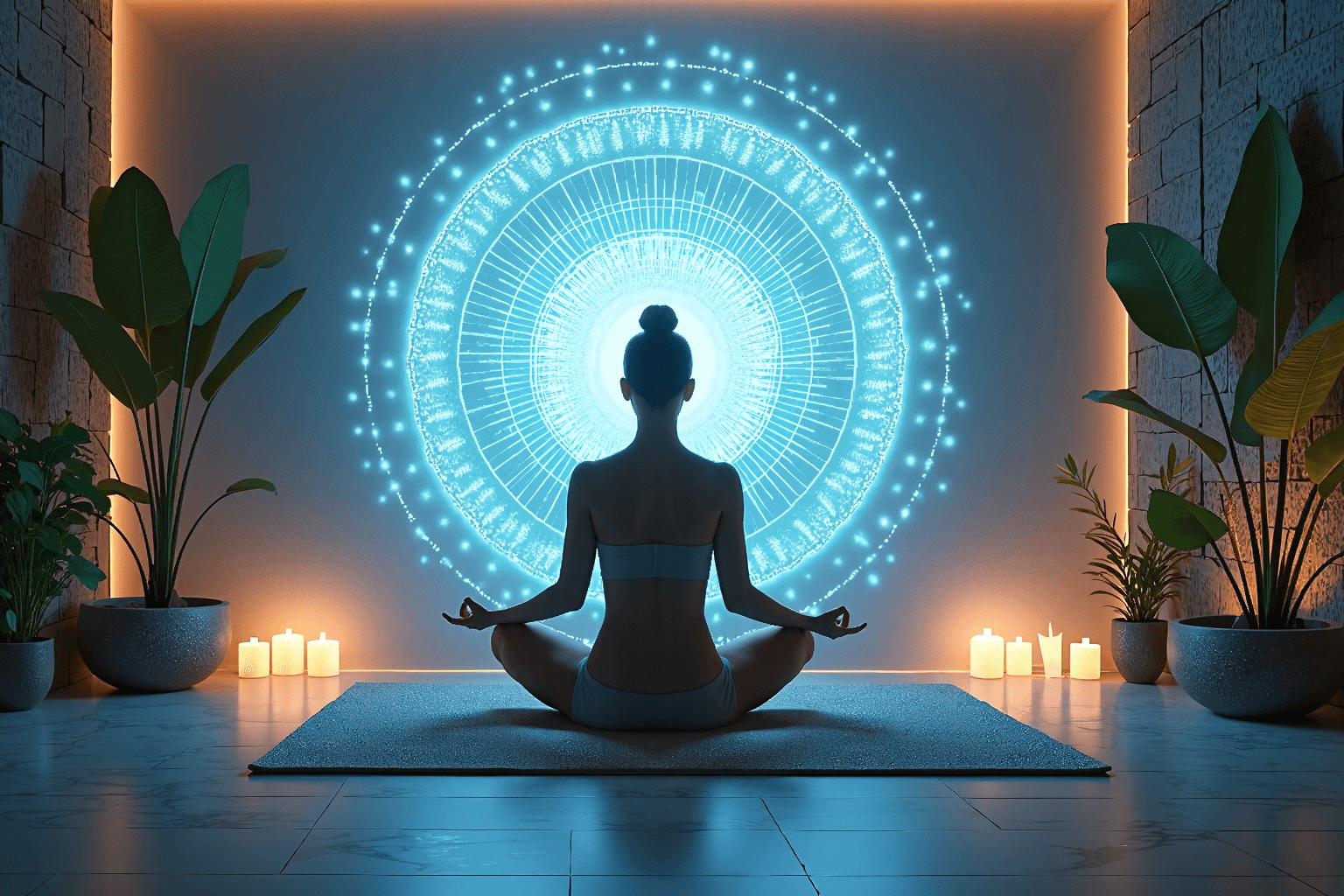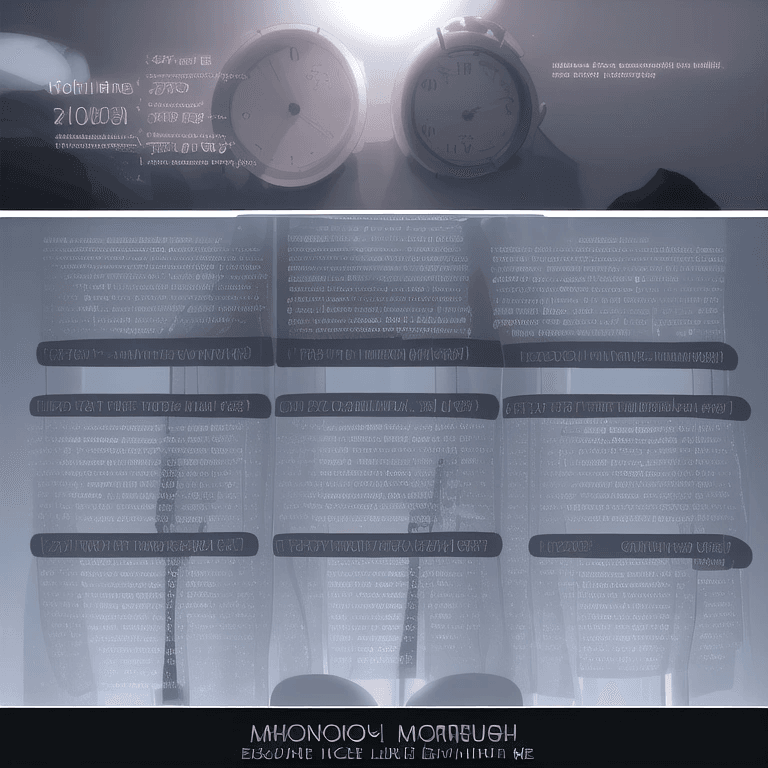The Future of Meditation: Embracing Technology for Enhanced Wellness
In our increasingly technology-driven world, the ancient practice of meditation is finding new expression, enhanced and personalized through advancements in biofeedback and architectural design. No longer confined to quiet corners and serene landscapes, meditation is being revolutionized by cutting-edge technology, offering personalized wellness experiences like never before. This evolution represents a convergence of traditional wisdom and modern innovation, creating opportunities for deeper, more accessible meditative practices. This article explores the innovative concept of designing meditation sanctuaries that integrate biometric feedback systems, creating spaces where technology and tranquility converge to promote deep relaxation and mindful awareness.
The modern meditation sanctuary transcends the limitations of physical space, leveraging technology to create immersive and adaptive environments. Imagine a dedicated room designed with acoustic dampening, incorporating natural materials like wood and stone to foster a sense of calm. Biometric sensors seamlessly integrated into the space monitor heart rate variability (HRV), skin temperature, and even brainwave activity, providing real-time insights into the user’s physiological state. This data informs the dynamic adjustment of ambient lighting, soundscapes, and even temperature, tailoring the environment to facilitate deeper relaxation and focus.
This personalized approach acknowledges that each individual’s meditative journey is unique, requiring a responsive and adaptable space. Architects and interior designers are now at the forefront of this movement, collaborating with technology experts to create spaces that respond to the user’s biofeedback in real-time. For example, as heart rate slows and breathing deepens, the lighting might shift to calming hues, and gentle nature sounds might fill the air. Conversely, if stress levels rise, indicated by increased heart rate or skin temperature, the system could subtly adjust the environment, perhaps introducing a calming visualization or adjusting the ambient temperature.
This personalized feedback loop enhances the individual’s awareness of their internal state, fostering a deeper connection between mind and body, a core principle of mindfulness meditation. The integration of biofeedback technology into meditation spaces isn’t just a futuristic concept; it’s already being implemented in innovative wellness centers and meditation studios around the world. These pioneering spaces demonstrate the transformative potential of technology to enhance meditation practices, offering valuable insights for architects, designers, and individuals seeking to create their own personalized sanctuaries.
From interactive light installations that respond to brainwave activity to personalized soundscapes that adapt to heart rate, these real-world examples showcase the tangible benefits of integrating technology with traditional meditative practices. This marks a new era of meditation, one where technology empowers individuals to cultivate mindfulness and achieve deeper states of relaxation and well-being. Ultimately, the design of the ultimate meditation sanctuary is about creating a harmonious balance between technology and tranquility. It’s about leveraging the power of biofeedback and personalized environments to deepen the meditative experience, making it more accessible and effective for individuals of all levels. By embracing technology in a mindful way, we can create spaces that not only promote relaxation and stress reduction but also empower individuals to cultivate a deeper understanding of their own internal landscape, fostering a more profound and personalized connection to the practice of meditation.
Architectural Harmony: Designing for Tranquility
Creating a truly transformative meditation space transcends mere aesthetics; it demands a deep understanding of how architectural elements can facilitate a profound connection with one’s inner self. Acoustics, a critical component often overlooked, must be meticulously addressed to minimize external distractions. Sound-dampening materials, strategically placed fountains, or even white noise systems can create an oasis of calm, shielding the meditator from the intrusive sounds of the outside world. Natural light, filtered through carefully positioned windows or skylights, plays a vital role in establishing a calming ambiance, regulating circadian rhythms, and fostering a sense of connection to the natural world.
Furthermore, proper ventilation, incorporating natural airflow or advanced filtration systems, ensures a fresh and invigorating atmosphere, free from stagnant air and pollutants, which can hinder deep relaxation. Incorporating natural elements like sustainably sourced wood, cool stone, and gently flowing water features further enhances the sense of tranquility, grounding the space in nature’s calming embrace. The Japanese practice of incorporating natural elements, known as ‘Shizen,’ exemplifies this principle, emphasizing the harmonious integration of nature and architecture to promote well-being.
The spatial layout should promote a sense of openness and flow, allowing for comfortable movement and positioning during various meditation practices, from seated mindfulness to gentle stretching or walking meditation. Consider the incorporation of flexible spaces that can adapt to different group sizes or individual preferences, ensuring the environment remains adaptable and supportive of diverse meditative needs. Imagine a softly lit room with strategically placed cushions, bathed in the warm glow of natural light filtering through a screen of bamboo.
A gentle trickle of water from a minimalist fountain provides a soothing backdrop, while the subtle aroma of essential oils diffuses through the air, creating a multi-sensory experience that promotes deep relaxation. This holistic approach to design, informed by principles of both ancient wisdom and modern technology, allows for a truly immersive and personalized meditative journey. Integrating smart technology, such as automated lighting controls and biofeedback-responsive soundscapes, can further enhance the experience, subtly adjusting the environment to support the individual’s physiological state, promoting deeper relaxation and focus.
This integration of technology and design allows the meditation sanctuary to become a dynamic partner in one’s wellness journey. The mindful incorporation of biofeedback technology seamlessly blends with these design elements, offering personalized insights into the user’s state of relaxation. By tracking heart rate variability and other physiological metrics, the environment can respond dynamically, adjusting lighting, soundscapes, and even subtle temperature changes to optimize the meditative experience. This personalized approach ensures that the sanctuary becomes a responsive and supportive space, catering to the unique needs of each individual, ultimately guiding them towards deeper states of relaxation and self-awareness.
Technology Integration: A Seamless Fusion of Tech and Tranquility
The seamless integration of biometric sensors forms the bedrock of a truly effective tech-enhanced meditation sanctuary. By embedding these sensors unobtrusively within the architectural design, the space transforms into an intelligent, responsive environment that caters to the user’s unique physiological needs. Heart rate variability (HRV) sensors, for instance, provide a window into the autonomic nervous system, offering real-time data on stress and relaxation levels. Skin temperature monitors can detect subtle shifts in blood flow, indicating emotional responses and levels of calm.
Even brainwave sensors, measuring electrical activity in the brain, can be incorporated to identify states of focus, relaxation, or agitation. This data, collected discreetly and non-invasively, becomes the foundation for a personalized meditation experience. For example, as the user’s HRV increases, indicating deeper relaxation, the lighting might gently dim, and the soundscape could transition to more soothing nature sounds. Conversely, if stress levels rise, reflected in decreased HRV and increased skin temperature, the system can subtly adjust the environment to promote a return to equilibrium.
Imagine a meditation room where the very walls seem to breathe with you, subtly adapting to your inner state, guiding you towards tranquility. This personalized approach transforms the meditation experience from a passive practice to an active, engaging dialogue between the individual and their environment. The architectural design of the sanctuary must consider the placement of these sensors to ensure accurate data capture without disrupting the aesthetic harmony of the space. Recessed lighting fixtures can house HRV sensors, while temperature sensors can be integrated into seating or handrails.
The key is to maintain a sense of tranquility and minimize the visual presence of technology, allowing the user to remain fully immersed in their meditative practice. This harmonious blend of technology and design is crucial for creating a truly transformative wellness space. Furthermore, the data collected by these sensors can offer valuable insights into the effectiveness of different meditation techniques. By tracking physiological responses over time, users can gain a deeper understanding of their own practice and identify the methods that best promote relaxation, focus, and overall well-being.
This data-driven approach empowers individuals to personalize their meditation practice, optimizing it for maximum benefit. The integration of biofeedback technology into meditation sanctuary design represents a significant advancement in the field of wellness. By leveraging the power of real-time physiological data, these spaces offer a personalized and engaging approach to meditation, making it more accessible and beneficial for individuals of all levels, from novice meditators to seasoned practitioners. This convergence of ancient practice and modern technology creates a powerful synergy, ushering in a new era of personalized wellness.
Personalized Meditation: Tailoring the Experience to Your Needs
Imagine a meditation space that responds to your individual needs in real-time. As your heart rate slows and your body relaxes, the lighting softens, and gentle nature sounds fill the air. If your stress levels rise, the system can subtly adjust the environment to help you regain focus. This personalized approach allows for a truly tailored meditation experience, maximizing the benefits of each session. This level of personalization hinges on the sophisticated integration of biofeedback technology within the meditation sanctuary design.
Consider, for instance, a system that monitors heart rate variability (HRV), a key indicator of the body’s stress response. Architecturally, the wellness space might feature dynamic lighting systems that shift from cooler, more stimulating hues to warmer, calming tones as HRV decreases, signaling deeper relaxation. Interior design elements, such as aromatherapy diffusers, could release subtle scents known for their stress-reducing properties, like lavender or chamomile, further enhancing the environment’s ability to promote mindfulness. Beyond lighting and scent, personalized meditation experiences can extend to auditory stimuli.
Biofeedback data can trigger changes in the ambient soundscape, transitioning from nature sounds to binaural beats designed to entrain brainwaves to specific frequencies associated with relaxation and focus. Furthermore, the system could even adjust the temperature of the room, subtly lowering it to promote a sense of calm, or activating a gentle breeze to mimic the feeling of being outdoors. These subtle, yet impactful, environmental adjustments work in concert to create a truly immersive and responsive meditation environment.
The beauty of this technology lies in its ability to adapt to the individual’s unique physiological profile. No two people experience meditation in the same way, and a personalized system recognizes this. For example, someone with a naturally lower heart rate might require less dramatic adjustments to the environment compared to someone with a tendency towards anxiety. The system learns and adapts over time, creating a continuously optimized meditation experience. This moves beyond a one-size-fits-all approach and embraces the nuances of individual physiology, making meditation more accessible and effective for a wider range of users.
Expert opinions in the field of wellness increasingly highlight the potential of personalized biofeedback in meditation. Dr. Sarah Williams, a leading researcher in mindfulness and technology, notes that “the integration of biometric data allows us to move beyond subjective experiences and objectively measure the impact of meditation practices. This data-driven approach can help individuals fine-tune their techniques and create environments that are truly conducive to relaxation and stress reduction.” This underscores the shift towards a more scientific and personalized approach to meditation, where technology serves as a powerful tool for enhancing well-being.
Real-World Examples: Pioneering the Future of Meditation
Several innovative wellness centers and meditation studios are already incorporating biofeedback technology to create immersive and personalized experiences. From interactive light installations that shift in color and intensity based on brainwave activity to personalized soundscapes that adapt to heart rate variability (HRV), these spaces demonstrate the immense potential of technology to enhance meditation practices and foster deep relaxation. These pioneering examples offer valuable insights for architects, interior designers, and individuals seeking to create their own tech-enhanced meditation sanctuaries, providing a glimpse into the future of wellness space design.
One compelling example is the use of EEG (electroencephalography) sensors integrated into meditation cushions or headbands. These sensors detect brainwave patterns associated with different states of consciousness, such as alpha waves during relaxation and theta waves during deep meditation. This real-time biofeedback data can then be used to control ambient lighting, aromatherapy diffusion, or even subtle vibrational elements within the meditation space, guiding the user towards a more profound state of mindfulness. Such integration allows for a truly personalized meditation experience, adapting to the user’s individual needs and helping them overcome common challenges such as mind-wandering or restlessness.
Another innovative application lies in the use of heart rate variability (HRV) biofeedback. HRV, the variation in time between heartbeats, is a key indicator of stress resilience and overall well-being. By monitoring HRV during meditation, the system can dynamically adjust the environment to promote greater coherence between the heart and brain. For instance, if the user’s HRV indicates high stress levels, the system might gently introduce calming nature sounds, dim the lights, or even provide subtle tactile feedback to encourage deeper breathing and relaxation.
This personalized approach ensures that the meditation experience is always optimized for maximum stress reduction and emotional regulation. Furthermore, the architectural design itself plays a crucial role in amplifying the benefits of biofeedback technology. Consider the use of biophilic design principles, incorporating natural materials, textures, and patterns that evoke a sense of calm and connection to nature. Integrating natural light through strategically placed skylights or windows, coupled with a carefully curated color palette of soothing blues, greens, and earth tones, can further enhance the meditative atmosphere.
The spatial layout should also be thoughtfully considered, creating a sense of privacy and enclosure while still allowing for a feeling of spaciousness and freedom. Beyond dedicated wellness centers, the principles of tech-enhanced meditation sanctuary design are also finding their way into residential spaces. Imagine a home meditation room design featuring a smart mirror that provides real-time feedback on your posture and breathing, guiding you towards optimal alignment for meditation. Or a personalized sound system that creates a unique soundscape based on your biometric data and preferences, promoting deep relaxation and mental clarity. These examples highlight the growing trend of integrating technology into our homes to support our well-being and create personalized havens for mindfulness and stress reduction.
Conclusion: A New Era of Meditation
By embracing technology, we can create meditation spaces that are not only aesthetically pleasing but also deeply effective in promoting wellness. These sanctuaries offer a personalized and engaging approach to meditation, making it more accessible and beneficial for individuals of all levels. The integration of biometric feedback and responsive design elements transforms the traditional meditation experience into a dynamic and interactive journey towards self-discovery and stress reduction. Imagine a space where the lighting shifts subtly in response to your heart rate variability, creating a calming ambiance as you enter a deeper meditative state.
This is the power of a technologically enhanced meditation sanctuary. These personalized wellness spaces leverage cutting-edge technology to create truly immersive experiences. Biofeedback sensors, seamlessly integrated into the design, monitor physiological indicators such as heart rate, skin temperature, and even brainwave activity. This real-time data informs the environment, allowing the space to respond dynamically to the user’s needs. As Dr. Emily Chen, a leading expert in biofeedback technology, explains, “This personalized approach allows individuals to gain a deeper understanding of their internal state and develop more effective self-regulation strategies.” For instance, if stress levels rise, the system might subtly adjust the ambient lighting to cooler tones and introduce calming nature sounds, gently guiding the individual back to a state of equilibrium.
This dynamic interplay between technology and the individual creates a uniquely personalized meditation experience. Architectural considerations are paramount in designing these transformative spaces. Natural materials such as wood and stone create a grounding atmosphere, while strategically placed water features contribute to a sense of tranquility. The acoustic design is carefully calibrated to minimize external distractions, ensuring a truly immersive experience. Natural light is maximized to regulate circadian rhythms and promote a sense of calm, while integrated ventilation systems maintain optimal air quality.
As renowned architect, David Lee, notes, “The goal is to create a sanctuary that supports both the physiological and psychological needs of the individual, fostering a deep connection with oneself and the surrounding environment.” Real-world examples of these innovative spaces are emerging globally. The BioZen Wellness Center in Los Angeles features interactive light installations that respond to brainwave activity, creating a mesmerizing visual experience that deepens meditative states. Similarly, the Tranquility Pod in New York offers personalized soundscapes that adapt to heart rate, guiding users through tailored meditation sessions.
These pioneering projects demonstrate the potential of technology to enhance traditional meditation practices, paving the way for a new era of personalized wellness. As we continue to explore the intersection of technology and mindfulness, the possibilities for enhancing our well-being are limitless. The meditation sanctuary of the future is not merely a place of quiet contemplation; it is a dynamic, responsive environment that empowers individuals to cultivate inner peace and achieve optimal well-being. These spaces offer a powerful synthesis of ancient wisdom and modern innovation, ushering in a new era of personalized and accessible meditation for all.


